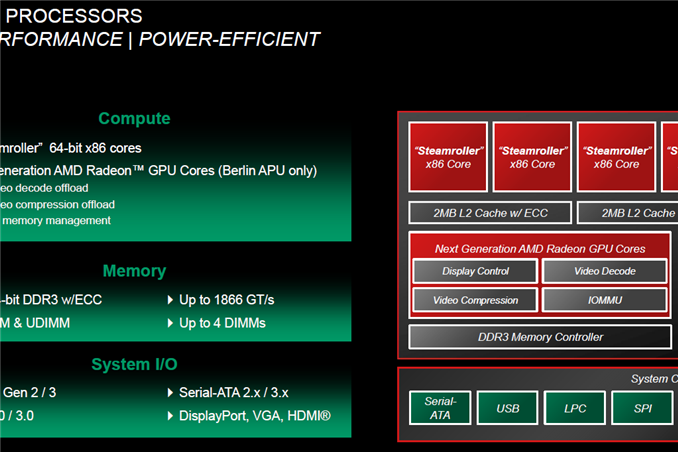AMD Evolving Fast to Survive in the Server Market Jungle
by Johan De Gelas on June 18, 2013 6:00 AM EST- Posted in
- AMD
- CPUs
- Arm
- Enterprise

There are two important trends in the server market: it is growing and it is evolving fast. It is growing fast as the number of client devices is exploding. Only one third of the world population has access to the internet, but the number of internet users is increasing by 8 to 12% each year.
Most of the processing happens now on the server side (“in the cloud”), so the server market is evolving fast as the more efficient an enterprise can deliver IT services to all those smartphones, tablets and pcs, the higher the profit margins and the survival chances.
And that is why there is so much interest in the new star, the “micro server”.
The Demand for Micro-Servers
The demand for very low power server is, although it is high on the hype curve, certainly not imaginary. When you run heterogeneous workloads, for example a mailserver, an OLAP database and several web and fileservers, some of these workloads will be demanding heavy processing power, others will be close to idle. In that case it is best to buy a dual "large core" CPU (or better) server, install a hypervisor and cut the machine up in resource pools. As one workload demands high processing power, your hardware and hypervisor will deliver it. Single thread performance will determine for a large part whether a complex SQL query is responded in a fraction of a second or several seconds. The virtualization layer gives you extra bonuses such as high availability, no more unplanned downtime etc.
If your web based workloads are very homogenous and you know how much horsepower your webapplication needs, things are very different. The virtualization layer is just adding complexity and cost now. In this case it is a lot more efficient to scale out than to divide your heavy server into virtual machines. The single thread performance has to be good enough to respond to a request quickly enough. But throughput demands can be handled by adding a load balancer in front of low power servers. It is much easier to scale this way.
The problem is that the your average server is not well suited for these kind of homogenous workloads. Yes, servers have become a lot more efficient by including advanced power management features. The introduction of CPU C-states and more efficient PSUs are among the top of technologies that saved a lot of power. However, even the most modern servers are still needlessly complex with lots of disk, network and other interfaces. A useless interface wastes a few hundred of mwatt and a less efficient PHY (Copper 10 Gbit Ethernet for example) wastes a few Watt, but in the end it adds up.











80 Comments
View All Comments
Wilco1 - Tuesday, June 18, 2013 - link
Didn't you read the news that Intel appears to be delaying 14nm introduction to 2015? And where did you see that Avoton has 20 cores? At best they might have 8.Nobody has compared A57 and Avoton branch predictors yet, so the jury is out on that. Same for power efficiency.
1008anan - Tuesday, June 18, 2013 - link
A friend Ashraf wrote an article about the 14 nm "delay" not being that big of a delay:http://seekingalpha.com/article/1503982-intel-s-14...
Avoton SoC packages might include 20 cores. More than one die per package.
JDG1980 - Tuesday, June 18, 2013 - link
I know I love to get my tech news from *investment* websites. (/sarcasm)Wilco1 - Tuesday, June 18, 2013 - link
A delay is a delay. And a link to a tech site which mentions that 20 core Avoton?iwod - Wednesday, June 19, 2013 - link
14nm is only being delayed on Desktop where there are NO competition. It is on schedule for Atom and Mobile CPU.LordanSS - Tuesday, June 18, 2013 - link
I believe the road AMD has chosen has a good future for them... the only problem is that, currently, that road is very rocky and difficult to drive through.Once they manage to fulfill their "Fusion" plans, we won't need to be bothered by the anemic FPU units paired on each Piledriver/Steamroller/whatever module, mostly because that computing should be done on the GPU (which, by the time the Fusion is complete, would be an integral part of the processor itself).
Unfortunately we're still a few years away from such... and I hope they (greatly) improve integer performance on their cores until then. But I do believe it's going to happen, and it'll be great.
Think of the old "math co-processors" of the past, back in the 386 days (they got integrated on the 486 models). The only difference now tho, is that a GCN IGP unit of today has an order of magnitude more compute/FPU power than Intel parts. If you fast forward to the future, and get that improved even more and fused into the CPU....
RandSec - Tuesday, June 18, 2013 - link
"AMD can't expect third-party code to be rewritten to accomodate their processors." AMD doesn't have the market share to tell software vendors to do things their way."Not true. AMD has *more* than mere market share, it has *complete* *market* *dominance* in the new gaming consoles. *All* of gaming graphics software expertise is now focused on leveraging CPU / GPU tradeoffs in the AMD APU design. If advantages really exist, they will be found and exposed, and new software will go that way as well, if only for AMD users. For example, it would seem that the GPU has plenty of fast FP, which need not also be in the CPU, *provided* it can be accessed easily without copying back and forth.
ruiner5000 - Tuesday, June 18, 2013 - link
What is this second great depression we are talking about? I think that is a myth. I don't see any dust bowls or soup lines. Certainly not here in Austin, where AMD is. What you had to wait an extra week to pick up your iPhone 5 and were depressed, and that's the 2nd great depression? Have you ever talked to anyone who was actually alive during the great depression? Wimps.SunLord - Tuesday, June 18, 2013 - link
We're not going to see any major x86 architecture changes from AMD till at least 2015 if not 2016 thats about how long it takes to design and deploy a newly designed architecture which is hopefully what the major rehires from last year will be working on. So we're stuck with mostly minor tweaks and enhancements till then.TiredOldFart2 - Tuesday, June 18, 2013 - link
Forget low power arm servers, give me a hybrid. Give me a box with x86 and arm cpus, and allocates resources based on use scenario.Give this to the market cheap and with low power usage and carve your way back into relevance.